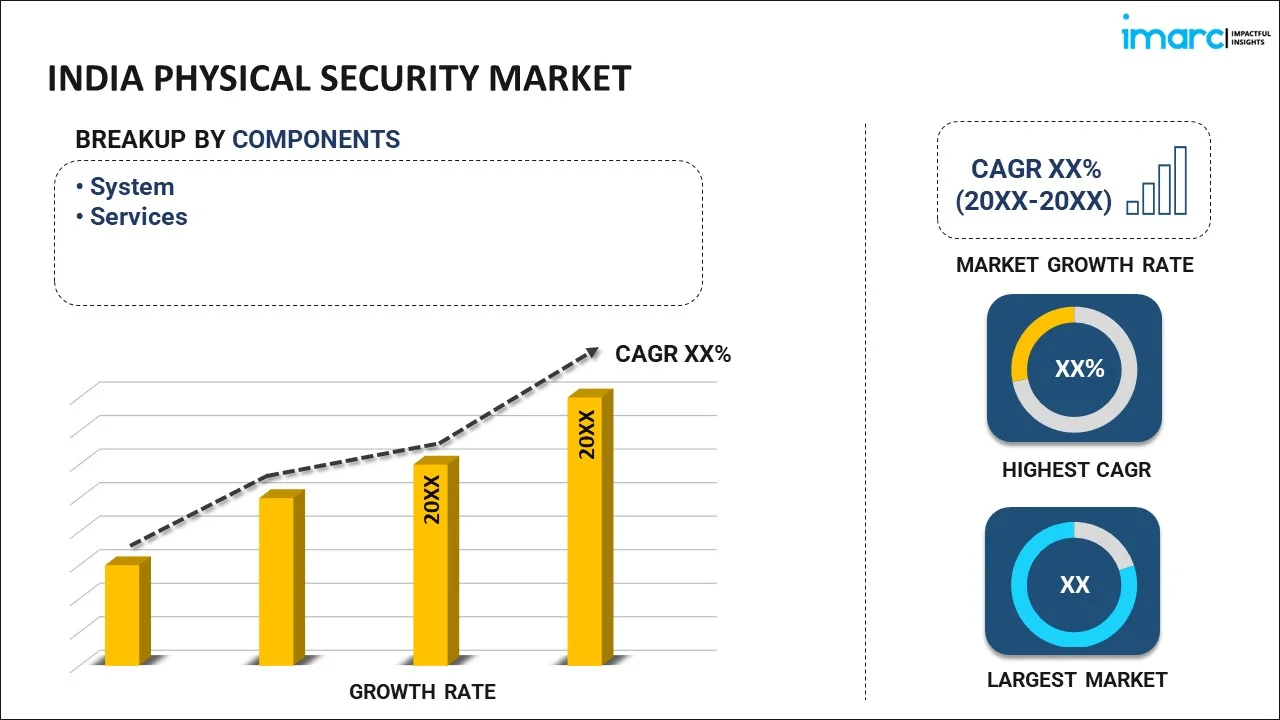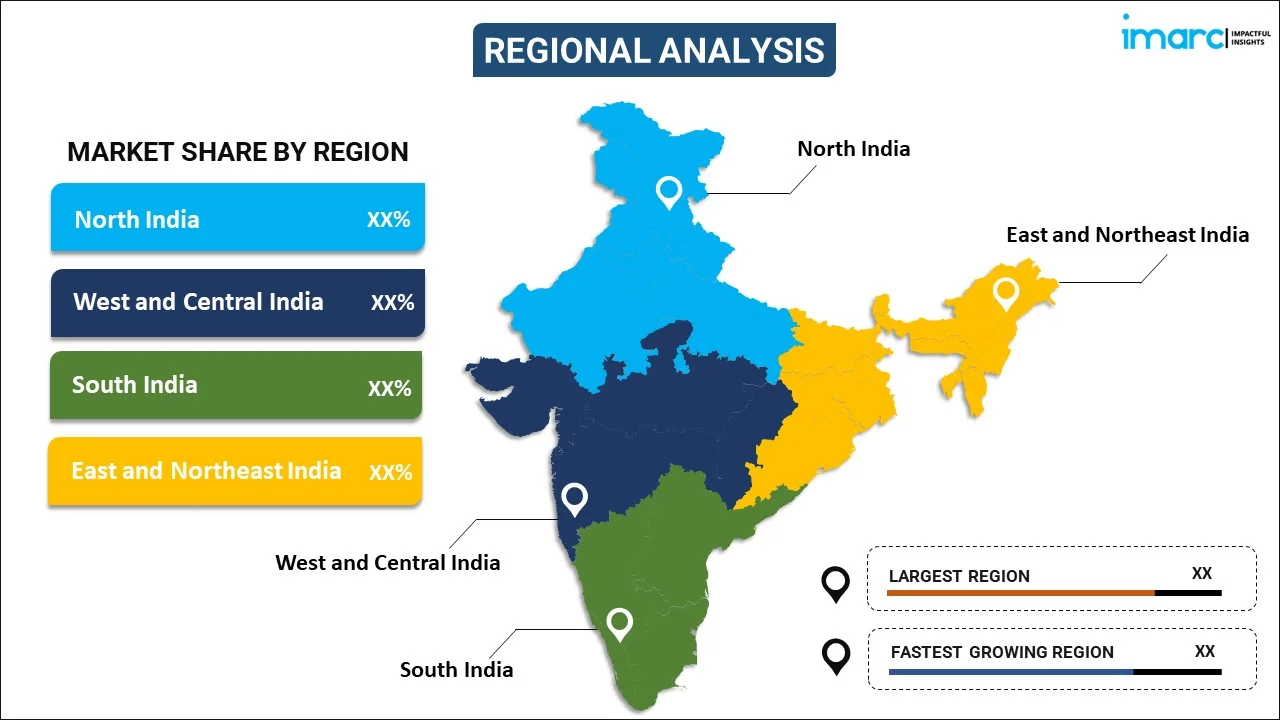
India Physical Security Market Report by Component (System, Services), Enterprise Size (Large Enterprises, Small and Medium-sized Enterprises), Industry Vertical (Retail, Transportation, Residential, IT and Telecom, BFSI, Government, and Others), and Region 2025-2033
Market Overview:
India physical security market size reached USD 6.9 Billion in 2024. Looking forward, IMARC Group expects the market to reach USD 10.9 Billion by 2033, exhibiting a growth rate (CAGR) of 5.2% during 2025-2033. The increasing advancements in video analytics, high-resolution cameras, and edge computing, which contribute to the growth of the video surveillance segment within physical security, are driving the market.
|
Report Attribute
|
Key Statistics
|
|---|---|
|
Base Year
|
2024
|
|
Forecast Years
|
2025-2033
|
|
Historical Years
|
2019-2024
|
|
Market Size in 2024
|
USD 6.9 Billion |
|
Market Forecast in 2033
|
USD 10.9 Billion |
| Market Growth Rate 2025-2033 | 5.2% |
Physical security is a critical aspect of safeguarding assets, people, and information within a physical space. It encompasses measures designed to prevent unauthorized access, protect against potential threats, and mitigate risks to physical infrastructure. This multifaceted approach involves the implementation of various security measures such as access control systems, surveillance cameras, perimeter barriers, and intrusion detection systems. These components work together to create a secure environment, deterring potential intruders and providing a rapid response to any security breaches. Physical security is not limited to traditional brick-and-mortar facilities; it extends to data centers, transportation hubs, and critical infrastructure. The goal is to create a robust defense system that ensures the safety of individuals, secures sensitive information, and safeguards valuable assets. As technology evolves, physical security measures continue to adapt, incorporating advanced technologies to address emerging threats and challenges.
India Physical Security Market Trends:
The physical security market in India is experiencing robust growth, primarily propelled by the increasing regional awareness and concerns regarding security threats. In recent years, organizations across various sectors have recognized the imperative need to safeguard their physical assets, personnel, and information from potential risks. Consequently, this growing awareness has led to a surge in the demand for sophisticated physical security solutions. Moreover, the rising incidents of unauthorized access, thefts, and acts of terrorism have underscored the necessity for robust security measures. In addition to this, advancements in technology play a pivotal role in driving the physical security market forward. The integration of cutting-edge technologies such as artificial intelligence, video analytics, and IoT (Internet of Things) into physical security solutions has enhanced their effectiveness and efficiency. Furthermore, the evolving regulatory landscape, with an emphasis on stringent security standards and compliance requirements, has become a significant driver for the market. As organizations strive to meet and exceed these standards, there is a corresponding increase in the adoption of comprehensive physical security solutions that address compliance needs. In summary, the confluence of heightened security awareness, technological innovations, and evolving regulatory frameworks collectively propels the growth of the physical security market in India.
India Physical Security Market Segmentation:
IMARC Group provides an analysis of the key trends in each segment of the market, along with forecasts at the country level for 2025-2033. Our report has categorized the market based on component, enterprise size, and industry vertical.
Component Insights:

- System
- Physical Access System
- Video Surveillance System
- Perimeter Intrusion and Detection
- Physical Security Information Management
- Others
- Services
- System Integration
- Remote Monitoring
- Others
The report has provided a detailed breakup and analysis of the market based on the component. This includes system (physical access system, video surveillance system, perimeter intrusion and detection, physical security information management, and others) and services (system integration, remote monitoring, and others).
Enterprise Size Insights:
- Large Enterprises
- Small and Medium-sized Enterprises
A detailed breakup and analysis of the market based on the enterprise size have also been provided in the report. This includes large enterprises and small and medium-sized enterprises.
Industry Vertical Insights:
- Retail
- Transportation
- Residential
- IT and Telecom
- BFSI
- Government
- Others
The report has provided a detailed breakup and analysis of the market based on the industry vertical. This includes retail, transportation, residential, IT and telecom, BFSI, government, and others.
Regional Insights:

- North India
- West and Central India
- South India
- East and Northeast India
The report has also provided a comprehensive analysis of all the major regional markets, which include North India, West and Central India, South India, and East and Northeast India.
Competitive Landscape:
The market research report has also provided a comprehensive analysis of the competitive landscape. Competitive analysis such as market structure, key player positioning, top winning strategies, competitive dashboard, and company evaluation quadrant has been covered in the report. Also, detailed profiles of all major companies have been provided.
India Physical Security Market Report Coverage:
| Report Features | Details |
|---|---|
| Base Year of the Analysis | 2024 |
| Historical Period | 2019-2024 |
| Forecast Period | 2025-2033 |
| Units | Billion USD |
| Scope of the Report | Exploration of Historical Trends and Market Outlook, Industry Catalysts and Challenges, Segment-Wise Historical and Future Market Assessment:
|
| Components Covered |
|
| Enterprise Sizes Covered | Large Enterprises, Small and Medium-sized Enterprises |
| Industry Verticals Covered | Retail, Transportation, Residential, IT and Telecom, BFSI, Government, Others |
| Regions Covered | North India, West and Central India, South India, East and Northeast India |
| Customization Scope | 10% Free Customization |
| Post-Sale Analyst Support | 10-12 Weeks |
| Delivery Format | PDF and Excel through Email (We can also provide the editable version of the report in PPT/Word format on special request) |
Key Questions Answered in This Report:
- How has the India physical security market performed so far and how will it perform in the coming years?
- What has been the impact of COVID-19 on the India physical security market?
- What is the breakup of the India physical security market on the basis of component?
- What is the breakup of the India physical security market on the basis of enterprise size?
- What is the breakup of the India physical security market on the basis of industry vertical?
- What are the various stages in the value chain of the India physical security market?
- What are the key driving factors and challenges in the India physical security?
- What is the structure of the India physical security market and who are the key players?
- What is the degree of competition in the India physical security market?
Key Benefits for Stakeholders:
- IMARC’s industry report offers a comprehensive quantitative analysis of various market segments, historical and current market trends, market forecasts, and dynamics of the India physical security market from 2019-2033.
- The research report provides the latest information on the market drivers, challenges, and opportunities in the India physical security market.
- Porter's five forces analysis assist stakeholders in assessing the impact of new entrants, competitive rivalry, supplier power, buyer power, and the threat of substitution. It helps stakeholders to analyze the level of competition within the India physical security industry and its attractiveness.
- Competitive landscape allows stakeholders to understand their competitive environment and provides an insight into the current positions of key players in the market.
Need more help?
- Speak to our experienced analysts for insights on the current market scenarios.
- Include additional segments and countries to customize the report as per your requirement.
- Gain an unparalleled competitive advantage in your domain by understanding how to utilize the report and positively impacting your operations and revenue.
- For further assistance, please connect with our analysts.

 Inquire Before Buying
Inquire Before Buying
 Speak to an Analyst
Speak to an Analyst
 Request Brochure
Request Brochure
 Request Customization
Request Customization



.webp)




.webp)












